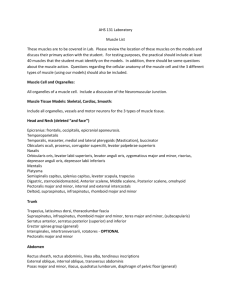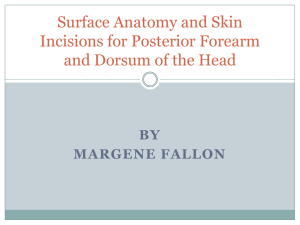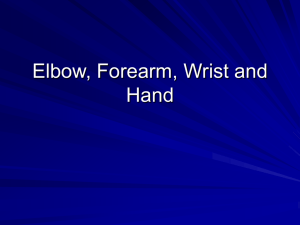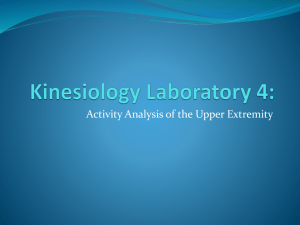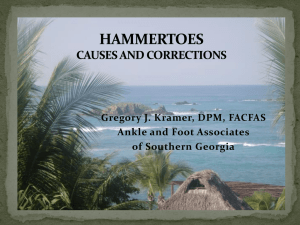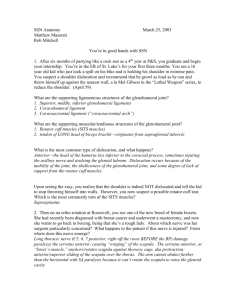Appendix 10.1.doc
advertisement
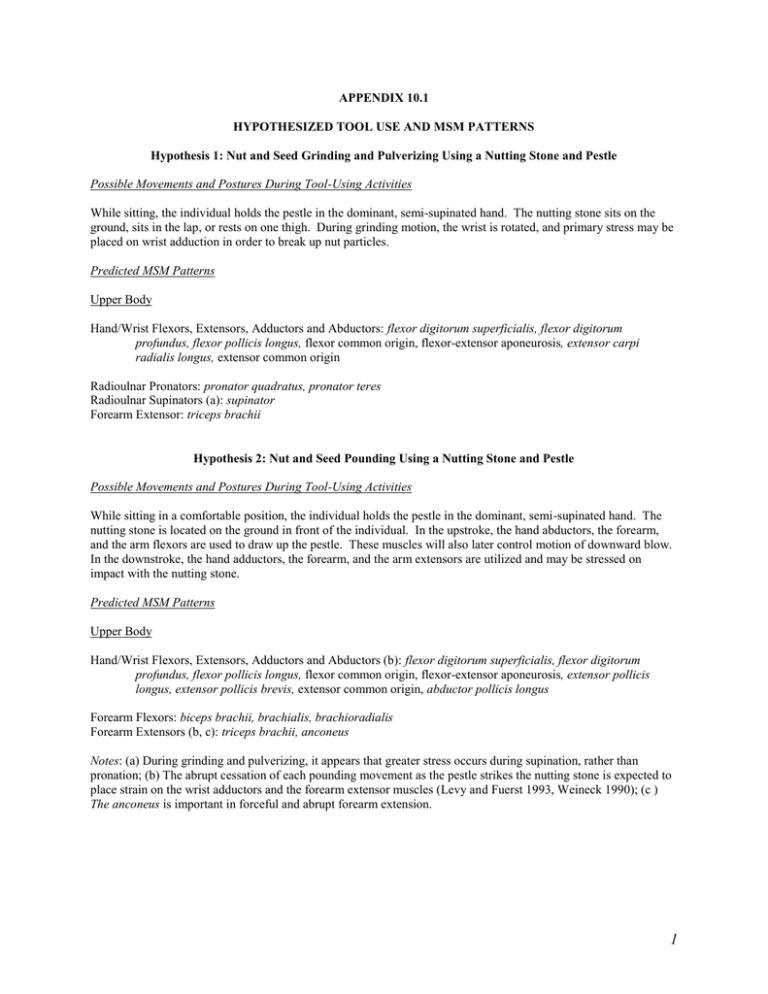
APPENDIX 10.1 HYPOTHESIZED TOOL USE AND MSM PATTERNS Hypothesis 1: Nut and Seed Grinding and Pulverizing Using a Nutting Stone and Pestle Possible Movements and Postures During Tool-Using Activities While sitting, the individual holds the pestle in the dominant, semi-supinated hand. The nutting stone sits on the ground, sits in the lap, or rests on one thigh. During grinding motion, the wrist is rotated, and primary stress may be placed on wrist adduction in order to break up nut particles. Predicted MSM Patterns Upper Body Hand/Wrist Flexors, Extensors, Adductors and Abductors: flexor digitorum superficialis, flexor digitorum profundus, flexor pollicis longus, flexor common origin, flexor-extensor aponeurosis, extensor carpi radialis longus, extensor common origin Radioulnar Pronators: pronator quadratus, pronator teres Radioulnar Supinators (a): supinator Forearm Extensor: triceps brachii Hypothesis 2: Nut and Seed Pounding Using a Nutting Stone and Pestle Possible Movements and Postures During Tool-Using Activities While sitting in a comfortable position, the individual holds the pestle in the dominant, semi-supinated hand. The nutting stone is located on the ground in front of the individual. In the upstroke, the hand abductors, the forearm, and the arm flexors are used to draw up the pestle. These muscles will also later control motion of downward blow. In the downstroke, the hand adductors, the forearm, and the arm extensors are utilized and may be stressed on impact with the nutting stone. Predicted MSM Patterns Upper Body Hand/Wrist Flexors, Extensors, Adductors and Abductors (b): flexor digitorum superficialis, flexor digitorum profundus, flexor pollicis longus, flexor common origin, flexor-extensor aponeurosis, extensor pollicis longus, extensor pollicis brevis, extensor common origin, abductor pollicis longus Forearm Flexors: biceps brachii, brachialis, brachioradialis Forearm Extensors (b, c): triceps brachii, anconeus Notes: (a) During grinding and pulverizing, it appears that greater stress occurs during supination, rather than pronation; (b) The abrupt cessation of each pounding movement as the pestle strikes the nutting stone is expected to place strain on the wrist adductors and the forearm extensor muscles (Levy and Fuerst 1993, Weineck 1990); (c ) The anconeus is important in forceful and abrupt forearm extension. 1 Hypothesis 3: Nut, Seed, and Grain Grinding Using a Mano and Metate Possible Movements and Postures During Tool-Using Activities While kneeling, the individual holds the mano in both pronated, flexed hands. The metate rests on the ground in front of the individual. In the “fore stroke,” the hands, wrists, and forearms extend, while the arms flex and the scapula abducts. During the “draw stroke,” the hands, wrists, and forearms flex, while the arms extend and the scapula adducts. Predicted MSM Patterns Upper Body Hand/Wrist Flexors, Extensors, Abductors, Adductors: flexor digitorum superficialis, flexor digitorum profundus, flexor pollicis longus, flexor common origin, flexor-extensor aponeurosis, extensor carpi radialis longus, extensor common origin Forearm Flexors (a): brachialis, brachioradialis Forearm Extensors (a): triceps brachii Arm Flexors: pectoralis major (upper fibers), deltoideus (anterior fibers) Arm Extensors: latissimus dorsi, teres major (b), deltoideus (posterior fibers) Scapular Abduction: serratus anterior, pectoralis minor Scapular Adduction (c): rhomboideus major, rhomboideus minor, trapezius Hypothesis 4: Food/Materials Preparation Using a Knife Possible Movements and Postures During Tool-Using Activities While sitting in a comfortable position, the individual holds the knife in the dominant hand, with the forearm pronated. Maximum stress is placed on the dominant hand during cutting while the wrist is flexing and the hand is adducting. Predicted MSM Patterns Upper Body Hand/Wrist Flexors, Extensors, Abductors, Adductors (d): flexor digitorum superficialis, flexor digitorum profundus, flexor pollicis longus, flexor common origin, flexor-extensor aponeurosis, extensor common origin Notes: (a) Merbs (1980) and Benson (1986) reported analogous osteoarthritic data associated with forearm flexion and extension resulting from the use of a mano and metate (‘metate forearm’); (b) Hawkey (1988); (c) Trapezius elevates, upwardly rotates, depresses and adducts the scapula (Calais-Germaine 1993); (d) Chaffin and Anderson (1991) cite wrist flexors and adductors as often injured/strained in the repeated use of a straight-backed knife while butchering animals. Hypothesis 5: Hide Preparation Using a Scraper (Sidescraping) Possible Movements and Postures During Tool-Using Activities The individual sits and holds the scraper in the dominant, pronated hand. The skin to be processed is possibly mounted to a frame and stretched taut. With each scrape, the wrist flexes and the forearm extends and supinates. 2 Predicted MSM Patterns Upper Body Hand/Wrist Flexors, Extensors, Abductors, and Adductors (a): flexor digitorum superficialis, flexor digitorum profundus, flexor common origin, extensor common origin Radioulnar Supination (b): supinator, biceps brachii Forearm Extensor: triceps brachii Hypothesis 6: Hide Preparation Using a Scraper (Endscraping) Possible Movements and Postures During Tool-Using Activities Turner The individual sits and holds the scraper in the dominant, semisupinated hand. The skin to be processed is possibly mounted to a frame and stretched taut. With each scrape, the wrist adducts while the forearm flexes. Madisonville (c) The individual sits and grasps the scraper in both pronated hands. The skin to be processed is possibly mounted to a frame and stretched taut. With each scrape, the wrist flexes while the arm extends. Predicted MSM Patterns Upper Body Turner Hand/Wrist Flexors, Extensors, Abductors, Adductors (a): flexor digitorum superficialis, flexor digitorum profundus, flexor common origin, flexor-extensor aponeurosis, abductor pollicis longus Forearm Extensors: triceps brachii Madisonville Hand/Wrist Flexors, Extensors, Abductors, Adductors (a): flexor digitorum superficialis, flexor digitorum profundus, flexor common origin, flexor-extensor aponeurosis, abductor pollicis longus Arm Extensors: latissimus dorsi, teres major, deltoideus (posterior fibers) Notes: (a) An electromyographic study of 10 muscles by Reece et al. (1997) indicated that the flexor digitorum profundus, extensor pollicis brevis and flexor pollicis longus are not recruited heavily during sidescraping or endscraping; (b) Biceps brachii is considered the muscle most involved when the forearm is supinated against resistance (Logan and McKinney 1982); (c) Scraping within Fort Ancient populations was frequently performed with a “beamer”, a large 7-10 inch long, two-handed scraper made from the metapodial bone of a deer (Otto 1980). Hypothesis 7: Flintknapping Using a Hammerstone Possible Movements and Postures During Tool-Using Activities The individual sits and holds the hammerstone in the dominant, pronated hand. The core (material to be flaked) is held in the other hand. During the upstroke the dominant hand and wrist extend while the forearm and arm flex. During the downstroke, the hand and wrist flex and adduct, while the forearm and arm extend. The blow impact of the hammerstone on the core will cause the non-dominant hand and wrist to flex in order to stabilize object, and may impose muscular stress. 3 Predicted MSM Patterns Upper Body Hand/Wrist Flexors, Extensors, Abductors, and Adductors (a, b): flexor digitorum superficialis, flexor digitorum profundus, flexor pollicis longus, flexor common origin, flexor-extensor aponeurosis, extensor carpi radialis longus, extensor indicis, extensor common origin Forearm Flexors (non-dominant hand): brachioradialis, brachialis, biceps brachii Forearm Extensors (dominant hand) (c): triceps brachii, anconeus Arm Flexors: deltoideus (anterior), pectoralis major (clavicular fibers) Arm Extensors: latissimus dorsi, teres major, deltoideus (posterior fibers) Notes: (a) Electromyographic studies have indicated that the flexor pollicis longus is recruited at the medium to high level during flintknapping and that stress will also be placed on the non-dominant hand to resist the force of each blow strike in an attempt to stabilize the hand (Marzke et al. 1997); (b) Extensor muscles can become strained from the rapid deceleration of a blow, such as occurs when the hammerstone lands on the the core surface (Levy and Fuerst 1993); (c) The anconeus is important in abrupt, forceful arm extension. Hypothesis 8: Soil Preparation Using a Hoe Possible Movements and Postures During Tool-Using Activities The individual stands with the feet spread slightly and the thighs, knees, and trunk slightly flexed. The hoe (a) is held with both semisupinated hands. In the upstroke the wrists abduct, the forearms and the arms flex, lifting the hoe, and the back extends. “When the arm flexes, the shoulder girdle must abduct, elevate, and upwardly rotate with clavicular rotation to maintain the glenoid fossa in the optimal position” (Hamill and Knutzen 1995:154). During the downstroke the hands adduct, and the wrists and trunk flex, while the forearms and arms extend. Once the hoe has touched the ground, the forearms and arms continue to extend, the scapula adducts, and the clavicle extends, drawing the hoe back. Predicted MSM Patterns Upper Body Hand/Wrist Flexors, Extensors, Abductors, and Adductors (b): flexor digitorum superficialis, flexor digitorum profundus, flexor pollicis longus, flexor common origin, flexor-extensor aponeurosis, extensor carpi radialis longus, extensor pollicis longus, extensor pollicis brevis, extensor common origin, abductor pollicis longus Forearm Flexors (c): biceps brachii, brachialis, brachioradialis Forearm Extensors (a, d): triceps brachii , anconeus Arm Flexors: pectoralis major (clavicular head), deltoideus (anterior) Arm Extensors (b,e): latissimus dorsi, teres major, deltoideus (posterior) Shoulder Movement and Stability (rotator cuff muscles): infraspinatus, supraspinatus, teres minor, subscapularis Adduction of the Scapula: rhomboideus major, rhomboideus minor, trapezius Abduction of the Scapula: serratus anterior, pectoralis minor Trunk Flexion (f): obliquus externus abdominus, obliquus internus abdominus 4 Lower Body Hip Extensors (g): semimembranosus, semitendinosus, biceps femoris, gluteus maximus Notes: (a) According to Otto (1980), the Fort Ancient peoples used hoes made not only of stone, but also of mussel shells, deer and elk scapulae, and elk antler. This is important because the weight of the tool may vary in this activity, thus affecting the level of potential muscle activity; (b) Muscles can become strained from the rapid deceleration of a blow, such as occurs when the hoe lands on the ground surface (Levy and Fuerst 1993); (c) The brachioradialis is particularly effective if the arm is semi-supinated (Calais-Germaine 1993); (d) The anconeus is important in abrupt and forceful forearm extension; (e) Lowering the arm against a resistance utilizes the latissimus dorsi and teres major working as a force couple with the rhomboids. Other muscles that resist the lowering action are pectoralis major, pectoralis minor, levator scapulae, and serratus anterior (Hamill and Knutzen 1995); (g) There may be side dominance in the use of obliquus externus abdominus, depending on the posture assumed during hoeing (Kumar 1995); (f) An electromyographic study by Marzke et al. (1988) indicated that the gluteus maximus is active when the trunk is maintained in partial flexion during lifting of heavy objects. Hypothesis 9: Soil Preparation and Harvesting Using a Digging Stick Possible Movements and Postures During Tool-Using Activities The individual stands with feet slightly spread, and knees and back slightly flexed (Marzke et al. 1988). The digging stick is held with both semisupinated hands. In the upstroke, the wrists abduct, the forearms and arms flex, and the trunk extends, lifting the digging stick to the point that the hands gripping the stick are above the head. “When the arm flexes, the shoulder girdle must abduct, elevate, and upwardly rotate with clavicular rotation to maintain the glenoid fossa in the optimal position” (Hamill and Knutzen 1995:154). During the frontal downstroke, the hands are in a line on a medial plane with the body. The hands flex, the wrists adduct, and the trunk flexes while the forearms and arms extend. Once the digging stick has touched the ground, the forearms and arms continue to extend, the clavicle, the humerus, and the scapula depress, pushing the digging stick into the ground. Predicted MSM Patterns Upper Body Hand/Wrist Flexors, Extensors, Abductors, and Adductors (a): flexor digitorum superficialis, flexor digitorum profundus, flexor pollicis longus, flexor common origin, flexor-extensor aponeurosis, extensor common origin, extensor carpi radialis longus Forearm Flexors (b): biceps brachii, brachialis, brachioradialis Forearm Extensors (a): triceps brachii, anconeus Arm Flexors: pectoralis major (clavicular head), deltoideus (anterior fibers) Arm Extensors (a, c): latissimus dorsi, teres major, deltoideus (posterior fibers) Scapula (Upward Rotation) (c): serratus anterior , upper trapezius, lower trapezius Scapula (Downward Rotation) (c): rhomboideus major, rhomboideus minor, levator scapulae Shoulder Girdle (Depression and Elevation) (c): pectoralis minor, levator scapulae, trapezius Shoulder Movement and Stability (rotator cuff muscles) (c, d): infraspinatus, supraspinatus, teres minor, subscapularis Trunk Flexion (a): obliquus externus abdominus, obliquus internus abdominus Lower Body Hip Extensors: semimembranosus, semitendinosus, biceps femoris, gluteus maximus (e) Notes: (a) Muscles can become strained from the rapid deceleration of a blow, such as occurs in the upper limbs when the hoe lands on the the ground surface (Levy and Fuerst 1993); (b) The brachioradialis is particularly 5 effective if the arm is semisupinated (Calais-Germaine 1993). (c) Lowering the arm against a resistance utilizes the latissimus dorsi and teres major working as a force couple with the rhomboideus major and rhomboideus minor. Other muscles that contribute to the lowering action are the pectoralis major, pectoralis minor, levator scapulae, and serratus anterior (Hamill and Knutzen 1995); (d) It has been documented that when a heavy object is lifted above shoulder level in an upward swing repeatedly, damage to the rotator cuff muscles can occur (Levy and Fuerst 1993; Peterson and Renstrom 1986); (e) An electromyographic study by Marzke et al. (1988) found that the gluteus maximus is significantly recruited during digging, by stabilizing the pelvis. Hypothesis 10: Clothing and Ornament Manufacture Using a Needle or Awl Possible Movements and Postures During Tool-Using Activities The individual sits and holds the needle or awl in the dominant hand, pinched between the first and second fingers and the thumb. The material to be sewn is held in the non-dominant hand. Sewing motion consists of flexion and extension of wrist and pronation and supination of forearm. Additional movements could include adduction and abduction of wrist. Predicted MSM Patterns Upper Body Hand/Wrist Flexors, Extensors, Abductors, and Adductors (a, b): flexor digitorum superficialis, flexor digitorum profundus, flexor pollicis longus, flexor common origin, flexor-extensor aponeurosis, extensor carpi adialis longus, extensor pollicis longus, extensor pollicis brevis, extensor common origin, abductor pollicis longus Radioulnar Pronators: pronator quadratus, pronator teres Radioulnar Supinators: supinator, biceps brachii Forearm Flexors: biceps brachii, brachioradialis, brachialis Arm Flexors: deltoideus (anterior), pectoralis major (clavicular head) Scapula (Upward Rotation) (c): serratus anterior, trapezius Shoulder Movement and Stability (rotator cuff muscles) (c): infraspinatus, supraspinatus, teres minor, subscapularis Hypothesis 11: Weaving Possible Movements and Postures During Tool-Using Activities Textile evidence indicates that the Ohio Hopewell wove in a style called “weft-twining” (Wilson 1979). This type of weaving requires flexion and extension of the fingers, adduction of the thumb and hand, wrist flexion and extension, and abduction of the arms. Predicted MSM Patterns Upper Body Hand/Wrist Flexors, Extensors, Abductors, and Adductors: flexor digitorum superficialis, flexor digitorum profundus, flexor pollicis longus, flexor common origin, flexor-extensor aponeurosis, extensor pollicis longus, extensor pollicis brevis, extensor indicis, extensor carpi radialis longus, extensor common origin Arm Abduction: deltoideus, supraspinatus Notes: (a) Merbs (1983) found evidence of “seamstress’s” fingers in Sadlermuit women, which he attributed to flexion of the fingers and forceful opposition of the thumb and forefinger; (b) Tennis elbow is a common injury to those who perform needlework; this condition involves the extensor carpi radialis longus and extensor common origin (Peterson and Renstrom 1986); (c) A study of occupational musculoskeletal disorders by Ranney et al. (1995) 6 indicated that the hand/wrist flexors, extensors, abductors, and adductors, the flexors of the forearm, the rotator cuff muscles, and the trapezius are subject to injurious stressors during sewing. Hypothesis 12: Using a Spear or an Atlatl Possible Movements and Postures During Tool-Using Activities While holding a spear or atlatl in the dominant flexed hand, the throwing arm is raised so that the arm is abducted and laterally rotated. In the “cocking phase” the hand is drawn above and behind the head, putting the elbow out in front of the wrist with the elbow in extreme rotation. The arm is abducted 90 degrees, the arm is externally rotated, the scapula adducts, and the forearm flexes. The body is propelled forward by extension of the lower extremity opposite to the throwing arm and the trunk rotates, putting the hand even farther behind the body. The spear or atlatl is accelerated by medial rotation of the arm and extension of the forearm. When the spear is released, or the item is projected into the air, the wrist flexes, snapping forward, and trunk rotation ceases. Predicted MSM Patterns Upper Body Hand Flexors, Extensors, Abductors, and Adductors (a-c): flexor digitorum superficialis, flexor digitorum profundus, flexor pollicis longus, flexor-extensor aponeurosis, flexor common origin, extensor carpi radialis longus, extensor pollicis longus, extensor pollicis brevis, extensor common origin, abductor pollicis longus Radioulnar Pronators (b, c): pronator quadratus, pronator teres Radioulnar Supinators (b, d - f): supinator, biceps brachii Forearm Flexors (b, e): brachialis, biceps brachii Forearm Extensors (b, c, e): triceps brachii (long fibers), anconeus Arm Flexors (e): pectoralis major, deltoideus (anterior) Arm Extensors (a, e, f): latissimus dorsi, teres major, deltoideus (posterior fibers) Arm Medial Rotators (a, e): subscapularis, latissimus dorsi, pectoralis major, teres major Arm Lateral Rotators (a, e): teres minor, infraspinatus Arm Diagonal Abduction (a, e): deltoideus (posterior fibers), infraspinatus, teres minor, triceps brachii (long fibers) Scapula (Adduction) (dominant arm)(e): rhomboideus major, rhomboideus minor, trapezius Scapula (Abduction) (dominant arm) (a, e): pectoralis minor, serratus anterior General Shoulder Movement and Stability (rotator cuff muscles) (a, e, g): infraspinatus, supraspinatus, teres minor, subscapularis Trunk Rotators: obliquus externus abdominus, obliquus internus abdominus Lower Body Hip Extensors: semimembranosus, semitendinosus, biceps femoris, gluteus maximus Hip Lateral Rotator (h): gluteus maximus Notes: (a) Muscles can become strained when the flexed wrist snaps forward or the rotator cuff muscles abruptly decelerate (Levy and Fuerst 1993; Peterson and Renstrom 1986); the flexor muscles of the wrist can become strained as they pull the wrist forward to throw the spear (Levy and Fuerst 1993); (b) Angel (1966b) reported flexion and extension of the elbow, as well as pronation and supination of the hand and forearm as occupational stressors related to spear and atlatl throwing; (c) The extensors of the forearm can be strained by giving extra power in a throw (Levy and Fuerst 1993); (d) Kennedy (1983,1985) reports supination and hyperextension of the (fore)arm as a stressor in spear throwing and use of an atlatl; (e) Electromyographic studies show that the muscles most used in throwing are as follows: biceps brachii, brachialis, deltoideus, infraspinatus, latissimus dorsi, pectoralis major, the rhomboids, serratus anterior, subscapularis, supraspinatus, teres minor, trapezius,and triceps brachii (Hamill and Knutzen 1995); (f) Logan and McKinney (1982) report that the biceps brachii is the muscle most involved in 7 supination against resistance; (g) The rotator cuff muscles may become strained when the distal end of the humerus is swung above the level of the shoulder (Levy and Fuerst 1993); (h) An electromyographic study by Marzke et al. (1988) found that the gluteus maximus is significantly recruited in throwing as it initiates rotation of the pelvis and brakes it as trunk rotation ceases and the forelimb accelerates. Hypothesis 13: Using a Bow and Arrow (a) Possible Movements and Postures During Tool-Using Activities The individual stands with feet spread slightly, and the bow is held in the semi-supinated, flexed, non-dominant hand. To stabilize the bow for the draw, the non-dominant arm is flexed, the forearm is fully extended, the wrist and hand are flexed, and the scapula is abducted. With the fingers of the semisupinated, dominant hand (first and second digits) flexed and “hooked” onto the bowstring, the bowstring is drawn back by flexing the forearm, laterally and horizontally rotating the adducted arm, and adducting the scapula. Predicted MSM Patterns Upper Body Hand/Wrist Flexors, Extensors, Abductors, and Adductors (b, c): flexor digitorum superficialis, flexor digitorum profundus, flexor common origin, flexor-extensor aponeurosis, extensor carpi radialis longus, extensor common origin Forearm Extensors (non-dominant hand and arm) (d): triceps brachii Arm Extensors (dominant hand and arm) (d): deltoideus (posterior fibers), latissimus dorsi, teres major Arm Lateral Rotators (d): teres minor, infraspinatus Arm Abductors (d): deltoideus, supraspinatus Trunk Rotators (d): obliquus externus abdominus, obliquus internus abdominus Notes: (a) According to Otto (1980), the Fort Ancient peoples were the first to use a bow and arrow, therefore this activity does not apply to Turner peoples; (b) Hand and wrist flexors should exhibit asymmetrical MSM distribution, owing to the differential position of the upper limbs during the use of a bow and arrow; (c) Present day archers most commonly utilize the wrist and hand flexors and extensors, arm extensors and abductors (bow hand), arm lateral rotators (arrow arm), and muscles of the trunk (Weineck 1990); (d) Dutour (1986), Kennedy (1983), and Hawkey (1988). Hypothesis 14: Running Possible Movements and Postures During Tool-Using Activities According to Hay and Reid (1982), running is comprised of three main stages: the supporting phase, the driving phase, and the recovery phase. In the supporting phase, one foot makes contact with the ground long enough to allow the other half of the body time to propel forward into position. When the foot makes contact with the ground, flexion of the hip, knee, and ankle joints is increased to cushion the shock of impact. In the driving phase, the body is projected forward and upward into the next stride. This requires forceful extension of the hip, knee, and ankle joints. During the recovery phase the foot is brought forward from behind the body to that point at which it next makes contact with the track. With each stride, the hips rotate. “Runners primarily work the extensor muscle groups of the lower body, namely, the lower back muscles, the buttock muscles, the hamstrings, and the calves” (Levy and Fuerst 1993:229). 8 Predicted MSM Patterns Lower Body Hip Extensors: semimembranosus, semitendinosus, biceps femoris, gluteus maximus Knee Extensors (a, b): vastus lateralis, vastus medialis, vastus intermedius, rectus femoris, gluteus maximus (superficial part) Plantar Flexors of Foot: peroneus longus, peroneus brevis, flexor digitorum longus, flexor hallucis longus, soleus, gastrocnemius Notes: (a) Runners are prone to injuries of the quadriceps (Levy and Fuerst 1993); (b) Females are more likely to have knee problems while running because the pelvis is wider, making the angle between the thigh and the calf sharper. This problem increases the chance that the kneecap will pull out of line and rub on the inside of its groove, causing knee pain (Levy and Fuerst 1993). 9

